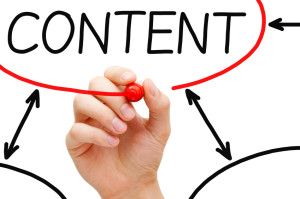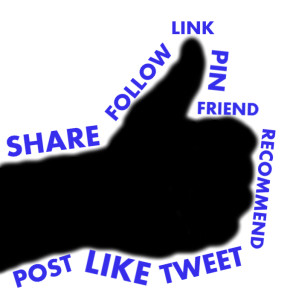by gabriel_sales | Sep 1, 2015
 At Gabriel Sales we look at sales and content marketing execution like we do any other business process – it should be just that, a process. Sales and marketing can no longer live in their own silos and operate independently. Efforts need to be aligned from initial targeting and strategy development and all the way through to client servicing post-purchase. There are two things that remain constant through this process: the presence of your team and educational content marketing. This blog will focus on the importance of content for the sales side of your organization, and how it can be best employed to convert more opportunities.
At Gabriel Sales we look at sales and content marketing execution like we do any other business process – it should be just that, a process. Sales and marketing can no longer live in their own silos and operate independently. Efforts need to be aligned from initial targeting and strategy development and all the way through to client servicing post-purchase. There are two things that remain constant through this process: the presence of your team and educational content marketing. This blog will focus on the importance of content for the sales side of your organization, and how it can be best employed to convert more opportunities.
The days of the hard sale and forcing buyers to purchase are long past. Buyers want to buy on their own terms. When you couple this with the increasing strain on organizational budgets and budget making, the job of the traditional sales rep is getting ever-more difficult. This shift in the relationship of the buyer and seller is driven even further by the abundance and proliferation of information in the digital space. Information is readily available for buyers to educate themselves, identify potential solutions and make purchase decisions. The role of the seller is to help them through this process while keeping your solution top of mind.
There is no substitute for talented, intelligent and effective sales reps. However, in today’s market, it is impossible for even the most exceptional reps to be effective if they don’t have the necessary content to support them throughout the sale. This blog will focus on what content should be available to help maximize efficiency and conversions, differentiate yourself within your competitive set and how that content should be organized to achieve these things.
Content marketing can be designed in order to increase the effectiveness of your sales team, not just fulfill obligations of the marketing department.
How is your content marketing going to empower your sales reps?
We view content organization in a three-stage system. It is imperative that you have ammo in place across all three fronts in order to effectively empower your sellers and provide value through your content. Your content should be clear, digestible and actionable.
The thought process here is that the role of your reps is to help move the buyer through each level of content as they themselves move through their own buying cycle. You have to hold their hand and make them feel like they are in control and buying on their own terms. If you do this effectively, your content will make the sale for you. A description of each stage of content that you need to address can be seen below:
Stage 1 – Inform your potential buyer that solutions exist and that there is a gap between their current state and the “ideal state.”
This is the education level of content. Content that falls in this stage is not designed to convert your buyer. Many times, your organization’s branding and offerings are not even discernable at this stage. The goal here is two-fold: educate the buyer on an area of solutions/offerings that your business lives in and bring to light for them the pains and needs that they need to solve within their role. You need your potential buyer to be aware that there are gaps between how they are operating and the most efficient level that they could operate at.
Your sales reps need this information so they can properly help the buyer along their purchase process. The most effective reps will know how to properly apply this information to prospects that are ready to be moved along the sales cycle.
Stage 2 – Educate your potential buyer on your solution.
Now that you are dealing with a buyer that is aware that they have performance gaps or inefficiencies, it is time to present how your solution can help them do their job more effectively. Use this stage of content to differentiate yourself within your buyers consideration set. Show how you out perform compared to the competition with your offering.
Your sales reps need this stage of content in order to keep moving the sale forward. The only way to properly convince a buyer of your effectiveness in today’s market is to show them concrete examples and allow them to come to the conclusion for themselves.
Stage 3 – Convert them!
Your buyer is aware of the market of solutions, they’ve identified pains and needs that they need to fulfill, and they know there is a gap between their current state and the “ideal state.”
Now is the appropriate time to utilize the more traditional hard sell. Pricing structures, key performance metrics and client servicing value-adds are going to be effective now that your buyer is prepared and ready to digest them.
This is where your most experienced sales folks will strive, but they will only do so if they have effective content to combine with their personal style and influence. Empower your reps effectively by putting the tools in their hands that they can use to close more deals faster.
Buyers are 100% in control of the buyer-seller relationship now. This is directly due to the availability of information present in the digital space. It is more important now than ever that your sales and marketing teams are aligned with content strategy geared to guiding the buyer to your solution; not forcing it upon them.
Gabriel Sales has excelled for over 10 years at developing strategy and content plans that result in successful, scalable and repeatable sales engines. For more insight on content marketing and sales execution, check out “Get Your Prospects to Take Action: Content Variety.”
If you’d like to chat with us directly about your own system or getting one into place, please don’t hesitate to contact us.
by gabriel_sales | Aug 26, 2015
If you would like to learn more about how we can help your B2B video efforts, please contact us.
by gabriel_sales | Aug 19, 2015
 This is the second blog in our series outlining the steps we take to build a successful outsourcing lead generation strategy and the sales consulting options we provide in identifying the Ideal Customer Profile. We also hope to provide the appropriate steps that you may take if you have the sales bandwidth.
This is the second blog in our series outlining the steps we take to build a successful outsourcing lead generation strategy and the sales consulting options we provide in identifying the Ideal Customer Profile. We also hope to provide the appropriate steps that you may take if you have the sales bandwidth.
In the first blog of the series, we discussed the importance of the sales consulting step, and how critical is has been to our success as an outsourcing sales company. As a refresher, it provides the opportunity to find and target your potential prospects based on a number of metrics related to both the company, and the actual decision maker you are engaging with.
When we launch, the first step we advocate for as part of our initial sales consulting (especially with Professional Services and highly complex sales) is to apply Pareto’s Principal to your existing pipe. Also known as, the “law of the vital few,” or the 80:20 rule; it states that 80% of your revenue will be derived from 20% of your customer base. These are the ideal customers we want to go after. You can then score the customers based on the metrics outlined in the first blog, with a specific focus on
- Title and level of contact
- Functional area
- Annual revenue and number of employees
- Vertical market
We also suggest that you look at the prospects that you want to avoid, which means looking at your failures. Significant information can be gained from prospects that do not want to engage, or are not qualified. Who makes up the 80% of your customers that drive 20% of revenue? These areas are the two biggest drivers:
- Functional area
- Level of contact
When we identify trends here, as a basic principal, we avoid them at all costs and label them as WCP (Worst Customer Profile). Next a decision has to be made about what should and shouldn’t be replicated in future lead targeting.
You can’t properly understand who you are trying to target if you don’t have a good picture of the market that they operate and live in. To identify the markets most conducive to providing opportunities, not just leads, Gabriel Sales does a three-part approach:
- We take your internal Ideal Customer Profile and map it against our historical data to examine connect ratios. This helps us to determine how many calls it typically takes to get the decision maker. From this we can do a semi-accurate forecast of how often they will pick up the phone or open an email. This lets us determine the ease of reaching.
- We do a deep dive leveraging Hoovers and other Database Research Tools to match SIC codes to your existing ICP to determine the target market size based on the criteria, a decision maker count by vertical and determined ease of reach.
- You look at Social Media including Linked In, You Tube and Influential Blogs to do a preliminary landscape of ancillary tactics to determine Social Media Adoption.
Finally, we recommend that you do an honest assessment about how well-prepared and equipped you are to Sell Money and provide true Success Stories for your new targets.
It’s about selling to the prospects you are best equipped to service. Winning comes out of alignment. So, we suggest you ask yourself: where does this customer alignment meet existing sales and marketing alignment, and how can we capitalize on it, and win deals faster? This step will make your outsourcing lead generation or internal lead generation more efficient and effective, and your ability to qualify sales prospects and increase your pipe velocity will grow.
The bottom line is simple: an Ideal Customer Profile starts with the end in mind. It will drive sustainable and exponential returns to your business by helping you:
- Find deals faster
- Close greater volume and higher deal size
- Build a strong pipe to nurture for future deals
- Eliminate customers that are a waste of time
- Increase your profitability
- Create a focus that drives sales and marketing alignment
Other blogs we suggest checking out if all the above makes sense:
by gabriel_sales | May 28, 2015
 Do you often wonder what you can do to get your content marketing to convert?
Do you often wonder what you can do to get your content marketing to convert?
While pondering this question myself I got to thinking about my daily life. Have I seen anything lately that has made me want to click, have I purchased anything recently after seeing an advertisement and what email marketing campaigns have I opened? Then I realized I was looking at this the wrong way. I needed to look more at my daily life and routines; what gets me to take action?
I often write myself reminders on fluorescent colored sticky notes and place them where I look daily. For example my notes usually end up on the bathroom mirror or on the refrigerator. This seems like a fool proof way to remind myself to do things. The problem is that the sticky notes catch my attention the first couple times, but eventually I procrastinate long enough or walk by them so often that I stop noticing the fluorescent notes dotted around my house.
Sometimes my cleverly placed notes do the trick but most of the time they get ignored. So, how do I remind myself to do things? It’s quite the process to be honest.
First I write it down on that hopeless little sticky note. You know, just in case it works.
Second, I put the to-do in my calendar with an alert triggered for a day or two before my deadline. Now we all know life can be crazy so when this alert goes off 50% of the time I’m already engaged in another activity.
This brings me to my third and final tactic; setting an alarm on my phone. Now, this alarm is set strategically for a time that I’m usually not busy, like after nine pm on a weekday or prior to my usual wake up alarm. When my alarm goes off at one of those times I know it is important and I’m sent into action.
What has become obvious to me is that it takes different types and repetitive reminders for me to take action. Now these aren’t life and death situations just to dos that should be done to make my life better and/or easier. I don’t think I’m the only one who works this way when presented with a good idea/opportunity that is non-emergent.
This behavior is also present in the buying process and needs to be addressed.
You aren’t going to hit your sales goals by engaging with a prospect once and it is rare to convert using only one sales/marketing tactic. One key to selling is content variety.
Like the sticky notes you need an introduction to create awareness of your product. Let’s say you start with cold calling. You get a few interested prospects but no one buys. What do you think is the next step? Continue to call or send them information on the product?
It’s time to engage your prospects with digital content. Get your prospects to look at you again and take notice – your content marketing is to your prospects as the calendar reminder is to me. Now that you have their attention address their pain points, educate them on your solution and move them towards the decision making stage.
Digital content is most easily shared with specific prospects via email. When using email as your communication platform your content is being delivered the same way every time but your content shouldn’t be the same. Make each email new and fresh with different subject lines and offers. The first step to getting prospects engaged is getting them to open the emails. Get variety in your subject lines by using questions and calls to action and also varying the length of the subject line.
Once your prospects are opening the emails you need them to click on your content. Again, if you’re always sending them the same thing they will start ignoring your efforts. In order to incorporate content variety; maybe you start by sending intro copy about your product, and then send a problem/solution video, then a microsite followed by case studies and or a white paper.
Now that your prospects are engaged it is key to make sure that the content on your website, blog and social media also have content variety. You’re targeting a large group of people with different pain points and personal preferences on how they consume information.
You have placed your sticky notes and you have enhanced awareness with your calendar reminder, now all you have to do is set the alarm to get your prospects to take action. This seems like a daunting task but it is easily done through scoring content and tracking prospects through marketing automation. You can see where your prospects are in the buying process by what links they are clicking, the pages they are visiting and whether or not they are filling out forms or downloading case studies or white papers. When you can see that they are engaging and getting close to the decision stage it is time to call them. Get them to schedule a time to view a demo and get in contact with your closer.
Your strategy may differ from this example, however, as long as you are communicating through multiple platforms and you have content variety you will obtain and keep the attention of your prospects. If you are relying on one repetitiveness without variety your prospects will stop noticing you and won’t take action.
For more tips on content creation to enhance your sales process, read “5 Steps to B2B Content Engagement Success.”
To learn more about Gabriel Sales and our sales marketing strategy please contact us.
by gabriel_sales | Jul 25, 2014
 This is part 2 of a blog series on ways to be more effective with B2B social media marketing. Click here for part one.
This is part 2 of a blog series on ways to be more effective with B2B social media marketing. Click here for part one.
2. Pay attention to your metadata
When most people think of content metadata, they are thinking about SEO. However, metadata can also be a big part of what drives engagement on social media. Many companies today post blog content without specifying an ‘exerpt’ or ‘meta description’ to be displayed on social media sharing sites. These small details, like the title of the article and the quick blurb that describes what its about, can really make a huge difference when it comes to engagement.
To learn more about sharing best practices and how to optimize your content to generate sharing, check out these tips from Facebook.
3. Use visual information like infographics and video
If your in B2B marketing currently, you’ve likely been a witness to the amazing rise on popularity of visual content over the last few years. The huge amount of visual marketing content like infographics, videos, webcasts, Slideshare presentations, etc. out there today shows that companies are finding success with this approach. A recent blog from Atomic Research suggests that one reason for this may be that “Your brain processes images faster than text and attaching a graphic to your content can create a mental foothold for your audience, which will result in reads, clicks and leads.”
This means that anything you can do to make your content more visual will likely make it more engaging for your audience on social media. For more tips on creating visual content, you can check out Atomic Research’s article here. For more on video in B2B, you can read last week’s blog that discusses recent barriers to success.
For more tips on B2B social media marketing, you can read 3 Ways to Use Twitter More Effectively for B2B Marketing.
by gabriel_sales | Jul 24, 2014
 In March, a story came out that found that stated the average American adult now spends 11 hours with digital media a day. While some of that time may be spent doing tasks like sending emails or surfing news sites, a 2014 marketing survey found that “than one in four minutes spent (28%) using smartphones is using social networking apps.”
In March, a story came out that found that stated the average American adult now spends 11 hours with digital media a day. While some of that time may be spent doing tasks like sending emails or surfing news sites, a 2014 marketing survey found that “than one in four minutes spent (28%) using smartphones is using social networking apps.”
Because consumers now spend more time than ever before interacting with digital devices and engaging in all types of digital content, it is no surprise that the social media marketing industry is still growing at a near exponential rate. With so many businesses now competing for their customer’s attention via digital devices and social media, it can be hard for smaller B2B companies to break through the noise and generate real value from social media marketing.
To help you be more effective with your B2B social media marketing efforts, here are three things that we see to be working right now:
- Get active on Google+
Most people have heard this by now, but in case you haven’t, it is worth repeating. Google’s social platform, Google+, is now arguably one of the most important social media platforms for business. This is in part because of the close relationship between +1’s (Google+’s version of ‘likes’) and high rankings on Google’s regular SERPs. Essentially, the more +1’s and shares a piece of content gets on Google+, the higher it will rank in Google overall.
For more tips on using Google+ in B2B, you can check out this infographic that has great step-by-step instructions for getting started and offers advice on what types of content to share, how to find influencers and more.
Continue reading the second half of this blog.
 At Gabriel Sales we look at sales and content marketing execution like we do any other business process – it should be just that, a process. Sales and marketing can no longer live in their own silos and operate independently. Efforts need to be aligned from initial targeting and strategy development and all the way through to client servicing post-purchase. There are two things that remain constant through this process: the presence of your team and educational content marketing. This blog will focus on the importance of content for the sales side of your organization, and how it can be best employed to convert more opportunities.
At Gabriel Sales we look at sales and content marketing execution like we do any other business process – it should be just that, a process. Sales and marketing can no longer live in their own silos and operate independently. Efforts need to be aligned from initial targeting and strategy development and all the way through to client servicing post-purchase. There are two things that remain constant through this process: the presence of your team and educational content marketing. This blog will focus on the importance of content for the sales side of your organization, and how it can be best employed to convert more opportunities.
 This is the second blog in our series outlining the steps we take to build a successful outsourcing lead generation strategy and the sales consulting options we provide in identifying the Ideal Customer Profile. We also hope to provide the appropriate steps that you may take if you have the sales bandwidth.
This is the second blog in our series outlining the steps we take to build a successful outsourcing lead generation strategy and the sales consulting options we provide in identifying the Ideal Customer Profile. We also hope to provide the appropriate steps that you may take if you have the sales bandwidth.


